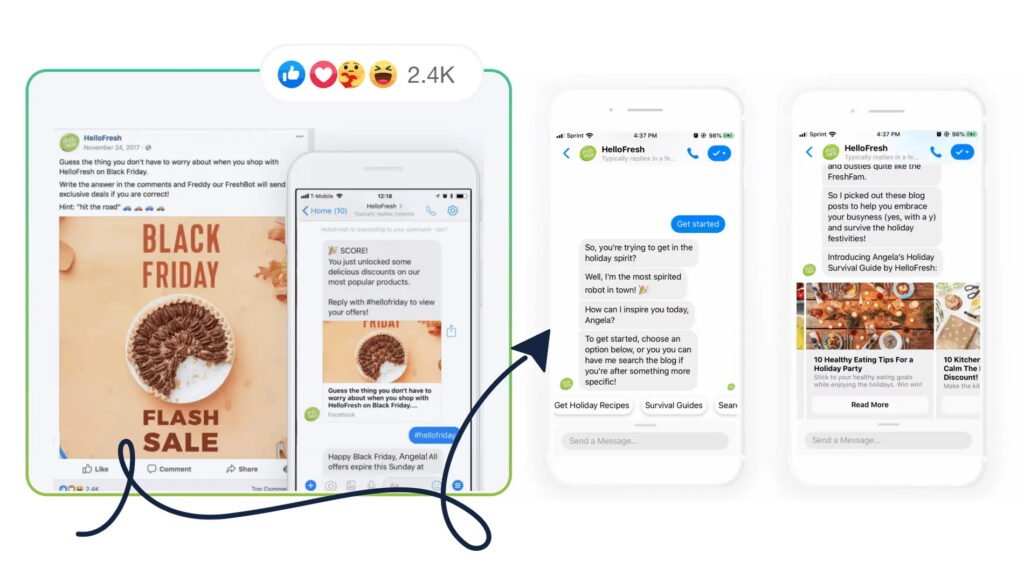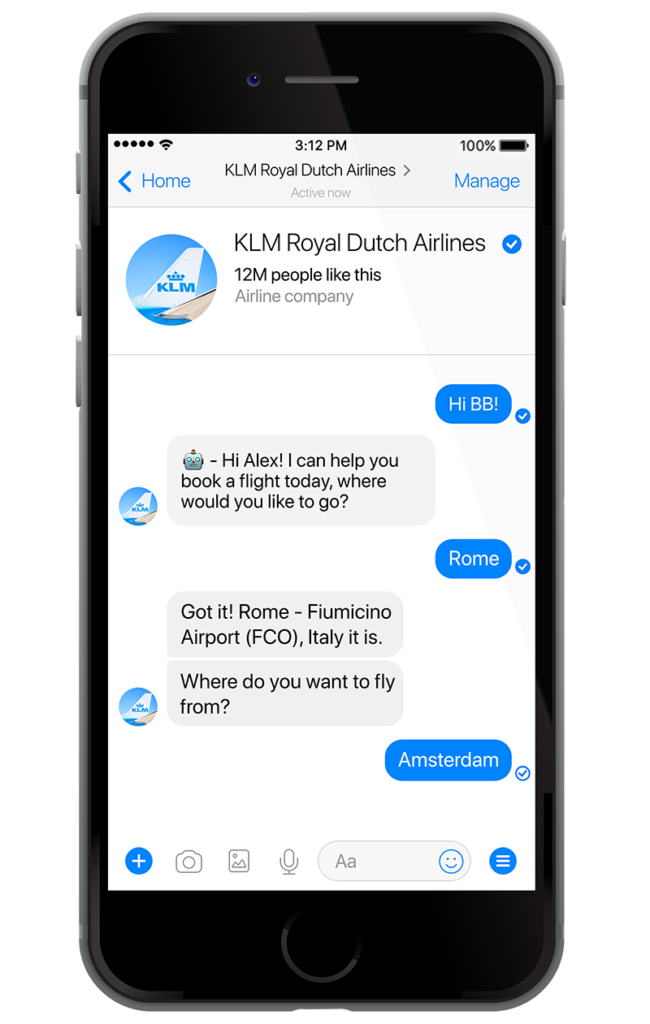Just imagine having access to a personal assistant that can answer all your questions, look for information, offer recommendations, complete orders, and more. Welcome to the possibility of an automated marketing strategy with chatbots. With chatbots in place, online businesses can now be assured that their customers never feel neglected. Whether it’s about real-time conversations, providing round-the-clock customer support or engaging customers with personalized offerings, chatbots today are getting more intelligent and are making unprecedented moves in the digital marketing world. In this post today, I will walk you through the best use-cases of deploying a chatbot for your online business with examples!
Basics first — What is a chatbot?
Chatbots are computer programs deployed on websites and apps that process, understand and respond back to human conversations, often in a human tone. We usually spot them in the form of a chat icon on the bottom-right corners of apps and websites.
Types of chatbots
Chatbots can be either rule-based or AI-powered, depending on their level of sophistication and functionality. As for the chatbot development and implementation costs, the price may vary significantly. But as a rule of thumb, rule-based chatbots are more affordable than AI-powered. Now, let’s get back to the tech side of the aspect.
- Rule-based chatbots always give similar answers or can respond differently if certain keywords are used in the queries. For example, think of a chatbot programmed to provide answers to a particular set of ‘Frequently Asked Questions’ on a website.
- AI-powered chatbots are comparatively more advanced as they use machine learning and natural language processing to understand the intent of the user’s message so as to adapt their responses in a conversational manner. It is important to understand this difference (and the type you are going to use) when you craft your chatbot marketing strategy.
What makes a good chatbot?
As you implement a chatbot on your app or website, make sure to follow these tips to improve the success of your chatbot marketing strategy:
- Integrate chatbots with your existing platforms. CRM, CMS, email marketing, or analytics platforms are all good options to sync. This way, you can personalize your messages based on user behavior and preferences and measure your chatbot’s impact on your marketing goals.
- Use a conversational user interface. Talking to a chatbot should be similar to talking to a human. Use natural language, avoid jargon and technical terms, use emojis and gifs to add emotion and personality, and provide clear and simple options for the user to choose from.
- Create a conversational flow chart. Try to offer users what they want without requiring or bothering them to give too much information. Create a conversational flow chart that maps out the possible scenarios, and use decision trees, buttons, quick replies, and menus to guide the user through the conversation.
- Keep interactions within an app. Leads can get lost when potential customers are sent to other sites. Try to keep the talk within the app or platform where your chatbot is located. Use rich media like images, videos, or carousels to show your products without leaving the chat.
An example of a chatbot with a well-defined marketing strategy is HubSpot’s GrowthBot. This chatbot helps marketers and salespeople with various tasks like generating leads, finding prospects’ contact information, analyzing competitors’ websites, creating blog post ideas, and more. It is available on Facebook Messenger and Slack and integrates with HubSpot’s CRM and other tools.

7 ways to use chatbots to transform your marketing strategy (with examples)
Now that we have understood the concept behind a chatbot and what makes a good chatbot, let’s now discuss 7 ways we can use chatbots on our websites for meeting various marketing goals or strategies.
1. Chatbots for lead generation and conversion
Chatbots deployed in such use-cases can segment inbound traffic, provide personalized recommendations, complete orders directly in the chat and reduce friction in the customer journey, so your lead generation and conversion rates would benefit a lot from using them. Here are a few possibilities:
- Increase conversion rate. Capture leads’ contact information, qualify them based on their needs and preferences, and nurture them with relevant content and offers.
- Increase average order value. Offer personalized recommendations based on customers’ purchase history, browsing behavior, and feedback. This can increase the chances of upselling and cross-selling additional products or services.
- Increase customer satisfaction. Provide a convenient shopping experience without making people fill out forms, navigate through multiple pages or wait for confirmation emails. This helps increase satisfaction, customer retention, and loyalty.
Best use-case example
HelloFresh’s Freddy is a good example. This chatbot helps customers discover new recipes, order ingredients, manage their subscriptions and get cooking tips. It is available on Facebook Messenger and WhatsApp. It also uses artificial intelligence to learn from customer feedback and improve its recommendations.

2. Chatbots for data collection and analysis
Chatbots can capture messaging data, provide insights into customer needs and wants, and inform marketing strategies, campaigns, and product development. Here are some benefits of using them for such purpose:
- Improve personalization. Collect data from customers’ interactions, i.e., their questions, answers, choices, and feedback, and use it to create customer profiles, segments, and personas that can help personalize future messages and offers.
- Improve optimization. Gather data about customers’ behavior, such as their click-through rates, conversion rates, retention rates, and churn rates, and use it to measure the performance of the chatbot and optimize it accordingly.
- Improve innovation. Accumulate data from customers’ opinions, such as their likes, dislikes, suggestions, and complaints, and use it to identify customer pain points, gaps, and opportunities to improve existing products or services or create new ones.
Best use-case example
An example of a chatbot that does data collection along with its other functions is Spotify’s Messenger Bot. It allows users to discover and share music via Facebook Messenger and also provides recommendations based on the user’s mood, activity, genre, or artist preferences. It also collects data from users’ listening behavior and feedback that Spotify can use to improve its music streaming service.

3. Chatbots for personalization
Personalization in chatbots refers to the ability to understand and respond to individual users based on their preferences and history. I.e., remember previous interactions, understand context, and provide personalized recommendations.
Personalization is a must-have for a good customer experience, and here are some ways how you can approach it:
- Use user data. CRM, social media, and web analytics can serve as data sources the chatbot can use to get a user’s name, location, purchase history, browsing behavior, etc., to tailor the conversation and the content it shows.
- Use natural language processing. Chatbots can use natural language processing to analyze the user’s message and extract information, and then make answers that match the user’s needs and expectations.
- Use machine learning. Chatbots can use machine learning to learn from user feedback and behavior and improve their response.
Best use-case example
Netflix’s “And Chill” chatbot helps users find something to watch on Netflix based on their mood, genre, or actor preferences. It also remembers the user’s choices and provides personalized recommendations for future sessions.

4. Chatbots for product presentation and shopping advice
Chatbots can use images, videos, carousels, or augmented reality to show products or services. They can also provide shopping advice based on customer needs, preferences, and feedback.
This comes with benefits like these:
- Increase engagement. Chatbots can use rich media like images, videos, carousels, or augmented reality to show different features, benefits, or use cases of the products or services.
- Increase trust. Chatbots can use natural language processing and machine learning to understand the customer’s needs, preferences, their feedback, and offer relevant and personalized suggestions.
- Increase sales. Chatbots can use secure payment systems like Stripe or PayPal to process payments directly from the chat without making the customer leave the platform or fill out forms.
Best use-case example
Sephora’s Virtual Artist chatbot allows users to try on different makeup products using augmented reality. It also supplies product information, ratings, reviews, and tutorials. Finally, users can buy the products directly from the chat, which gives a better user experience than being redirected elsewhere or having to go scroll through the shop to find the product they want.

5. Chatbots for cross-selling and upselling
Cross-selling is when a chatbot suggests additional products or services that complement the customer’s current purchase. Upselling is when it offers a more expensive or premium product with more value or benefits than the customer’s current choice.
In both cases, if the customer takes the chatbot’s advice, the company earns a higher average order value and revenue. There are benefits both for the customers and the business in it:
- It raises customer satisfaction. Chatbots can increase customer satisfaction by providing a more helpful and relevant service to each customer, and this advice would come faster and easier than browsing and choosing by themselves.
- It increases customer loyalty. Chatbots that are helpful and “understand” customer needs and expectations, provide good suggestions, save customers’ time, and offer a better user experience.
Best use-case example
1-800-Flowers’ GWYN chatbot helps users find and order the perfect flowers for any occasion. It also suggests additional products like chocolates, balloons, or teddy bears that complement the flowers. Like with Sephora’s Visual Artist, users also can order the products directly from the chat.

6. Chatbots for content marketing
These chatbots can help you deliver relevant and valuable content to your audience, i.e., blog posts, ebooks, videos, podcasts, etc. They can also help segment the audience based on their interests, preferences, and behavior, and tailor the content accordingly.
Here are a few examples of what benefits it can bring:
- Increase your website traffic and engagement by providing useful and interactive content to your visitors.
- Generate leads and conversions by offering gated content, such as ebooks or webinars, in exchange for contact information or subscriptions.
- Nurture your leads and customers by sending personalized content recommendations, follow-ups, and reminders via email or messaging platforms.
Best use-case example
An example of this is Huffington Post Entertainment. This chatbot is available on Facebook Messenger and provides users with curated news stories, videos, quizzes, and polls related to entertainment topics. Users can also subscribe to daily or weekly updates on their favorite topics or celebrities. The chatbot uses natural language processing (NLP) to understand user queries and preferences and provides relevant and engaging content accordingly.

7. Chatbots for customer care
One of the most common use cases for chatbots is customer care. This is the area where chatbots deliver value by providing instant responses to customer queries, resolving simple issues, creating tickets for human agents, and improving customer satisfaction.
Here are some benefits of using chatbots for customer care:
- Reduces response time. Chatbots can answer customer queries in real-time, 24/7, without making them wait on hold or in a queue.
- Reduces operational costs. Chatbots can handle repetitive and low-level tasks, such as providing FAQs, confirming orders, updating account information, etc.
- Increases customer retention. Chatbots can provide personalized and proactive customer service, such as sending reminders, notifications, tips, offers, etc.
Best use-case example
KLM’s BlueBot chatbot helps customers book flights, check-in, get boarding passes, change seats, get flight status updates, and more. It is available on Facebook Messenger, WhatsApp, Twitter, and voice platforms like Google Assistant and Amazon Alexa. It also integrates with KLM’s live chat agents when needed.

Conclusion
Chatbots are powerful tools that can transform your digital marketing strategy. They can help you provide personalized, engaging, efficient, and convenient experiences to your customers throughout the purchasing journey. They can also help you generate leads, increase conversions, collect feedback, improve loyalty, and more.
If you want to try chatbots for your digital marketing strategy, you can start by defining your goals, audience, tone, content, and channels for your chatbot. You can also use some of the examples and tips we provided in this article to inspire you.

